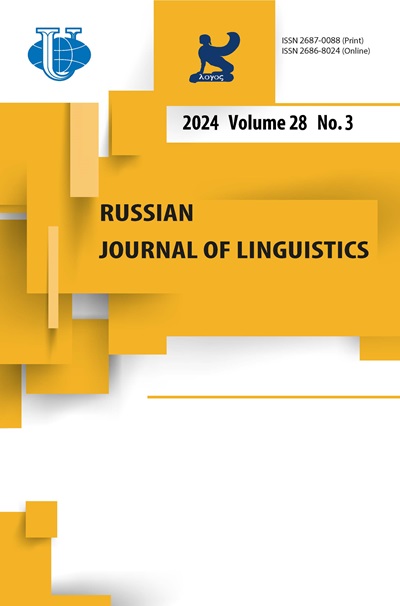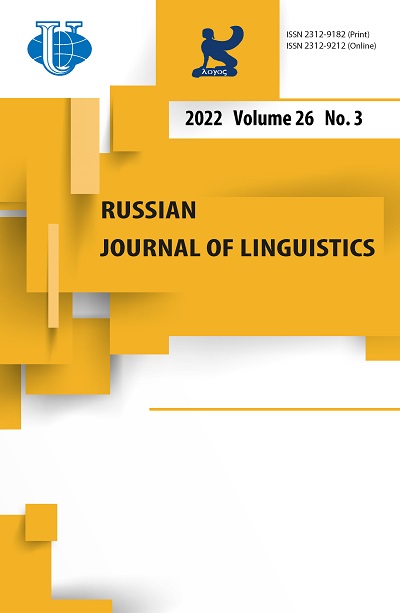Двойное или половинное прочтение, двойное или полное значение: амфибологический и анаколутический синтаксис глазами переводчиков Корана
- Авторы: Хассанейн Х.1
-
Учреждения:
- Университет Принца Саттама бин Аббдулазиза
- Выпуск: Том 26, № 3 (2022)
- Страницы: 668-700
- Раздел: Статьи
- URL: https://journals.rudn.ru/linguistics/article/view/32090
- DOI: https://doi.org/10.22363/2687-0088-26692
Цитировать
Полный текст
Аннотация
Коран изобилует многоплановыми двусмысленными и эллиптическими конструкциями, которые характеризуют его своеобразный риторический стиль, а также осложняют поиск формального соответствия и динамической/ функциональной эквивалентности между арабским и английским языками. Хотя в переводоведении существуют многочисленные исследования, посвященные двусмысленности и эллипсису в Коране, проблемы амфибологического и анаколутического синтаксиса изучены недостаточно. В связи с этим возникает необходимость рассмотреть два синтаксических явления - амфибологию ( al-labsan-nahwi: ) и анаколуф ( fuqda:nat-tata:bu ) - с точки зрения переводчиков Корана и оценить качество перевода путем транспонирования двусмысленности и интерпретативной неоднозначности Корана из арабского языка в английский. Основная задача исследования - проанализировать, каким образом переводчики Корана при переводе стихов справлялись с амфиболией и анаколуфом, соответственно обозначенными в статье значками (∴ ∴) и (…). В процессе работы использовался качественный контрастивный метод для проведения контрастивного переводческого анализа типологически ограниченного количества амфибологических и анаколутических стихов, отобранных из Коранического корпуса арабского языка (QAC). Результаты проведенных изысканий показывают, что амфибология и анаколуф столь трудны для переводчиков Корана, что наблюдаются существенные расхождения между тем, как разные переводчики подходят к их интерпретации. Одни прибегают к толкованиям, другие - к импликации, третьи - к нейтрализации идеи сообщения, что свидетельствует о гиперсубъективности и ассиметричности выбора интерпретации. Вклад исследования в кораническое переводоведение заключается в том, что оно показывает значимость паратекстов и эпитекстов для анафибологического и анаколутического синтаксиса в переводе. Паратексты и эпитексты выступают как «порог интерпретации» в терминологии Ж. Женетта (Genette 1997), привнося в текст перевода значимые подтексты. Подтексты необходимы для предоставления существенной информации или комментария к переводу оригинального текста.
Об авторах
Хамада Хассанейн
Университет Принца Саттама бин Аббдулазиза
Автор, ответственный за переписку.
Email: h.hassanein@psau.edu.sa
ORCID iD: 0000-0003-3770-6405
доцент
Эль-Хардж, Саудовская АравияСписок литературы
- Abdelaal, Noureldin. 2019. Faithfulness in the translation of the Holy Quran: Revisiting the skopos theory. SAGE Open July-September. 1-14. https://doi.org/10.1177/2158244019873013
- Abdul-Ghafour, Abdul-Qader, Norsima M. Awal, Intan S. Zainudin & Ashinida Aladdin. 2019. The interplay of Qur’ānic synonymy and polysemy with special reference to al-asfār and al-kutub (the Books) and their English translations. 3L: The Southeast Asian Journal of English Language Studies 25 (1). 129-143. http://dx.doi.org/10.17576/3L-2019-2501-10
- Abdul-Raof, Hussein. 1999. Untranslatability of semantically oriented Qur’anic syntax. Offshoot: A Journal of Translation and Comparative Studies II. 39-46
- Abdul-Raof, Hussein. 2001. Qur’an Translation: Discourse, Texture and Exegesis. Surrey: Curzon Press.
- Abdul-Raof, Hussein. 2019. Text Linguistics of Qur’anic Discourse: An Analysis. London and New York: Routledge.
- Abu-Chacra, Faruk. 2007. Arabic: An Essential Grammar. London and New York: Routledge.
- Ad-Darwi:sh, Muhyi:-d-di:n. 1980. Icra:b al-Qurʔa:n al-Kari:m wa-Baya:nih [‘The Parsing and Eloquence of the Holy Qur’an’]. Hums: Al-Yama:ma.
- Al-Ali, Mohammed N. & Mohammad Q. Al-Zoubi. 2009. Different pausing, different meaning: Translating Qur’anic verses containing syntactic ambiguity. Perspectives: Studies in Translation Theory and Practice 17. 227-241
- Alduhaim, Asmaa. 2021. Translating near-synonyms in the Quran: A semantic analysis of three near-synonyms and their English translations. 3L: The Southeast Asian Journal of English Language Studies 27 (1). 76 - 89. http://dx.doi.org/10.17576/3L-2021-2701-06
- Al-Jarrah, Rasheed S., Ahmad M. Abu-Dalu & Hisham Obiedat. 2018. Translation of strategic ambiguity: A relevance theoretic analysis. Poznań Studies in Contemporary Linguistics 54. 1-35. https://doi.org/10.1515/psicl-2018-0001
- Al-Kharabsheh, Aladdin & Bakri Al-Azzam. 2008. Translating the invisible in the Qur'an. Babel 54 (1). 1-18. https://doi.org/10.1075/babel.54.1.02kha
- Allaithy, Ahmed. 2019. Challenges in translating the Qur’ān - translating the untranslatable: Omission/ellipsis. In Stanley D. Brunn & Roland Kehrein (eds.), Handbook of the changing world language map, 1-35. Vienna: Springer
- Az-Zamakhshari:, Abu:-l-Qa:sim. 1998. Al-Kashsha:f [‘The Detector’]. 1st edn. Rev. by ʿA:dil A. ʿAbd al-Mawju:d & ʿAli: M. Muʿawwad. Riyadh: Maktabat Al-ʿUbayka:n
- Baker, Mona. 1992. In Other Words: A Coursebook on Translation. London and New York: Routledge
- Becher, Viktor. 2011. Explicitation and implicitation in translation A corpus-based study of English-German and German-English translations of business texts. PhD thesis, University of Hamburg, Germany
- Bisiada, Mario. 2016. Lösen Sie Schachtelsätze Möglichst auf: The impact of editorial guidelines on sentence splitting in German business article translations. Applied Linguistics 37 (3). 1-24. https://doi.org/10.1093/applin/amu035
- Blumczynski, Piotr. 2017. Ubiquitous Translation. London and New York: Routledge
- Bousquet, Kathryn, Tamara Y. Swaab & Debra L. Long. 2019. The use of context in resolving syntactic ambiguity: Structural and semantic influences. Language, Cognition and Neuroscience 35. 354-376. https://doi.org/10.1080/23273798.2019.1622750
- Bussmann, Hadumod. 1996. Routledge Dictionary of Language and Linguistics. Trans. and rev. by Gregory Trauth & Kerstin Kazzazi. London and New York: Routledge.
- Catford, John. 1965. A Linguistic Theory of Translation. London: Oxford University.
- Crystal, David. 2008. A Dictionary of Linguistics and Phonetics. 6th edn. Oxford: Blackwell.
- Daas, Qa:sim. 2004. Icra:b al-Qurʔa:n al-Kari:m [‘Parsing the Holy Qur’an’]. Damascus: Da:r al-Muni:r
- Daimi, Kevin. 2001. Identifying syntactic ambiguities in single-parse Arabic sentence. Computers and the Humanities 35 (3). 333-349
- Darir, Hassane. 2012. Translating the implicit: Low-contextualization in the case of translating the Qur’an into English. In Hassane Darir, Yu:suf Al-Idri:si: & cAbdu-l-Hami:d Zahi:d (eds.), Tarjamat al-bala:gha al-qurʔa:niyya bayna asʔilat al-huwwiya wa-thaqa:fat al-a:khar [‘Translating Qur’anic rhetoric between inquiries about identity and culture of the other’], 297-327. Irbid: Modern Books World
- Dickens, James, Sándor Hervey & Ian Higgins. 2016. Thinking Arabic Translation: A Course in Translation Method: Arabic to English. 2nd edn. London and New York: Routledge.
- Dupriez, Bernard. 1991. A Dictionary of Literary Devices. Trans. and adapt. by Albert W. Halsall. Toronto: University of Toronto Press.
- El-Hadary, Tariq H. 2008. Equivalence and translatability of Qur’ānic discourse: A comparative and analytical evaluation. PhD thesis, University of Leeds, UK
- Genette, Gérard. 1997. Paratexts: Thresholds of Interpretation (Trans. Jane E. Lewin). Cambridge: Cambridge University Press.
- Greene, Roland, Stephen Cushman, Clare Cavanagh, Jahan Ramazani & Paul Rouzer. 2012. The Princeton Encyclopedia of Poetry and Poetics. 4th edn. Princeton: Princeton University Press.
- Greene, Roland & Stephen Cushman. 2016. The Princeton Handbook of Poetic Terms. 3rd edn. Princeton: Princeton University Press.
- Ha:mid, cAbdu-l-sala:m A. & Majdi: Qandi:l. 2019. David Justice wa-ara:ʔuh fi: mazhar tara:ki:b al-carabiyya [‘David Justice and his views on aspects of Arabic syntax’]. ALMICHAAL 21. 75-122.
- Hassanein, Hamada. 2017. Translating aspects of lexical-semantic opposition from Qur’anic Arabic into English: A cross-linguistic perspective.” Perspectives: Studies in Translation Theory and Practice 25 (1). 137-156. https://doi.org/10.1080/0907676X.2016.1159236
- Hassanein, Hamada & Jens Scheiner. 2020. The Early Muslim Conquest of Syria: An English Translation of al-Azdī’s Futūḥ al-Shām. London and New York: Routledge.
- House, Juliane. 2019. Translation as a prime player in intercultural communication. Applied Linguistics 41 (1). 10-29. https://doi.org/10.1093/applin/amz007
- Ibn ʿA:shu:r, At-Ta:hir. 1984. Tafsi:r at-Tahri:r wa-t-Tanwi:r [‘The Exegesis of Liberation and Enlightenment’]. Tu:nis: Ad-Dār At-Tu:nisiyya li-l-Nashr.
- cImra:n, Hamdi: B. 2018. Min Ishka:liyya:t al-Tarjama Waqf al-Muca:naqa fi: al-Qurʔa:n al-Kari:m [‘Of the problematics of translation is the inter-embracing pause in the holy Qur’an’]. Giresun: Aswa:t li-l-Dira:sa:t wa-l-Nashr
- Justice, David. 1987. The Semantics of Form in Arabic in the Mirror of European Languages. Amsterdam: John Benjamins Publishing.
- Kaltenböck, Gunther. 2007. Spoken parenthetical clauses in English: A taxonomy. In Nicole Dehé & Yordanka Kavalova (eds.), Parentheticals, 25-52. Amsterdam: John Benjamins Publishing.
- Kha:tir, Sulayma:n Y. 2000. Manhaj Si:bawayh fi: al-Istishha:d bi-l-Quraʔn al-Kari:m wa-Tawji:h Qira:ʔa:tih wa-Maʔa:khidh bacd al-Muhdathi:n calayh [‘Sibawayh’s Method for Quoting from the Glorious Qur’an and Directing its Readings and the Criticisms Levied against it by Modern Grammarians’]. PhD thesis, Omdurman Islamic University, Sudan.
- Kiss, Tibor & Artemis Alexiadou. 2015. Syntax: Theory and Analysis. Berlin: De Gruyter Mouton.
- Klaudy, Kinga. 2005. Implicitation in translation: Empirical evidence for operational symmetry in translation. Across Languages and Cultures 6. 13-28. https://doi.org/10.1556/Acr.6.2005.1.2
- Lane, Robert. 2018. Peirce on Realism and Idealism. Cambridge: Cambridge University Press.
- Langley, Larret. 1835. A Manual of the Figures of Rhetoric, etc. Doncaster: C. White, Baxter-Gate.
- MacDonald, C. Maryellen, Neal J. Pearlmutter & Mark S. Seidenberg. 1994. Lexical nature of syntactic ambiguity resolution. Psychological Review 101. 676-703. https://doi.org/10.1037/0033-295X.101.4.676
- Makutoane, Tshokolo J., Cynthia L. Miller-Naudé & Jacobus A. Naudé. 2015. Similarity and alterity in translating the orality of the Old Testament in Oral Cultures. Translation Studies 8 (2). 156-174. https://doi.org/10.1080/14781700.2014.992462
- Mieszkowski, Jan. 2009. Who’s afraid of anacoluthon? MLN 124. 648-665. 10.1353/mln.0.0145
- Mir, Mustansir. 2006. Language. In Andrew Rippin (ed.), The Blackwell companion to the Qur’an, 88-106. MA: Blackwell Publishing.
- Mohaghegh, Ameneh & Hossein Pirnajmuddin. 2013. The trace of translators’ ideology: A case study of English translations of the Qur’an. 3L: The Southeast Asian Journal of English Language Studies 19 (1). 51-64.
- Munday, Jeremy. 2008. Introducing Translation Studies: Theories and Applications. 2nd edn. London and New York: Routledge.
- Munday, Jeremy. 2016. Introducing Translation Studies: Theories and Applications. 4th edn. London and New York: Routledge.
- Mustafa, Burçin K. 2019. Ambiguity, ideology, and doctrine propagation in Qur’an translation. Journal of Qur’anic Studies 21. 21-49. https://doi.org/10.3366/jqs.2019.0367
- Najjar, Ibrahim, Soh Kwee & Thabet Abu al-Haj. 2019. Mode in Arabic-English Translation: With Reference to the Quran. Russian Journal of Linguistics 23 (2). 509-522. https://doi.org/10.22363/2312-9182-2019-23-2-509-522
- Naudé, Jacobus A. 2010. Religious translation. In Yves Gambier & Luc van Doorslaer (eds.), Handbook of translation studies, 285-293. Amsterdam/Philadelphia: John Benjamins Publishing.
- Newmark, Peter. 1982. Approaches to Translation. Oxford: Pergamon Press.
- Newmark, Peter. 1988. A Textbook of Translation. New Jersey: Prentice Hall.
- Nida, Eugene. 2001. Contexts in Translating. Amsterdam/Philadelphia: John Benjamins Publishing.
- Omer, Sir El-Khatim. 1997. Stopping or pausing during Quranic recitation and its impact on meaning. Journal of King Saud University: Educational Science and Islamic Studies 9 (1). 113-149.
- Pym, Anthony. 1995. European translation studies, une science qui dérange, and why equivalence needn’t be a dirty Word. Traduction, Terminologie, Rédaction 8. 153-176. https://doi.org/10.7202/037200aradresse copiéeun
- Rangarajan, Sudarsan. 2017. The anacoluthon in le Rouge et le Noir: Cutting cords and tying knots. Neophilologus 101. 387-397. https://doi.org/10.1007/s11061-017-9521-0
- Raoufkazemi, Fatemeh, Majid Khorsand, Moussa P. Asl & Amin Amirdabbaghian. 2020. Expertise and explicitation in English translations of the holy Quran. 3L: The Southeast Asian Journal of English Language Studies 26 (3). 154-169. http://dx.doi.org/10.17576/3L-2020-2603-12
- Salama, Amir. 2021. A methodology for Qur’anic lexical translation: Synergizing semantic preference, discourse prosody, and para/intertextuality. Translation Spaces 10 (2). 278-305. https://doi.org/10.1075/ts.20042.sal
- Schipper, Jeremy. 2012. The syntax and rhetoric of Ruth 1:9a. Vetus Testamentum 62. 642-645. https://doi.org/10.1163/15685330-12341085
- Simpson, Paul. 2004. Stylistics: A Resource Book for Students. London and New York: Routledge.
- Toury, Gideon. 1995. Descriptive Translation Studies and Beyond. Amsterdam/Philadelphia: Benjamins.
- Tüfekçican, Dilek. 2017. The representation of anacoluthon in Waiting for Godot by Samuel Beckett. Atatürk Üniversitesi Sosyal Bilimler Enstitüsü Dergisi 21 (1). 1-17.
- Vinay, Jean-Paul & Jean Darbelnet. 1995. Comparative Stylistics of French and English: A Methodology for Translation. Amsterdam & Philadelphia: John Benjamins.
- Wansbrough, John. 1970. Maja:z al-Qurʔa:n: Periphrastic exegesis. Bulletin of the School of Oriental and African Studies 33. 247-266. https://doi.org/10.1017/S0041977X00103325

















